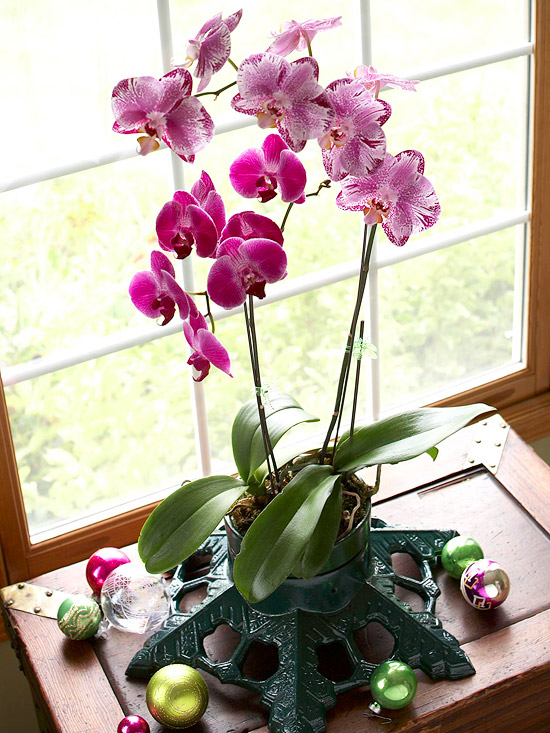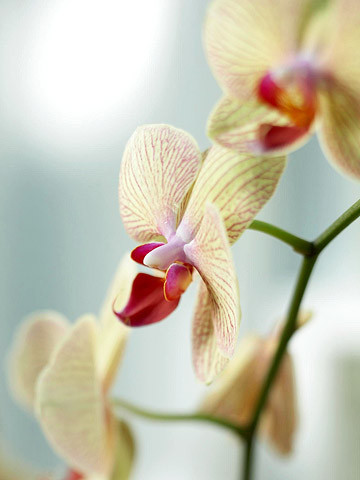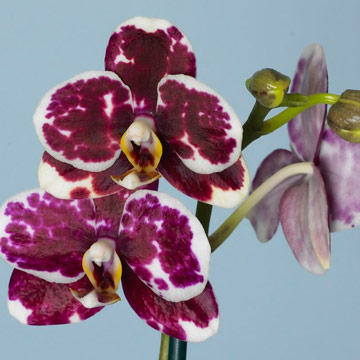





Look beyond the pretty face when deciding which orchid to grow indoors. First, assess the growing conditions you can offer an orchid, and make your choice from there. Light, temperature, humidity, your watering tendencies, and fertilizing all play a role in growing orchids.

The single most important variable when growing orchids indoors is light. Orchids that prefer high light -- unobstructed sunlight, streaming through a clear, south-facing window or into a greenhouse for 6 to 8 hours -- include vandas and angraecums.
Medium-high light orchids, such as phragmipediums, oncidiums, and dendrobiums, grow in locations that are bright but not directly sunny. Eastern and western exposures are often medium-high light locations, although a western exposure may be warmer. The light intensity is the same, but the air temperature has increased.
Medium-low light is appropriate for phalaenopsis (moth orchids) and paphiopedilums. It may be an east- or west-facing window with no direct sun. It may also be an open northern exposure with no obstructions and some additional reflected light.
Low light is usually a limited northern exposure or any exposure where the light is blocked by an overhang, trees, or neighboring buildings. Jewel orchids grow in low light.
Generally, orchids can be grouped into three temperature categories: cool, warm, and intermediate. Buy a high-low thermometer to measure the temperature range in your orchid location. After that, choosing a suitable orchid is simple. As with light, some orchids easily adapt to more than one temperature range.
Most orchids we grow indoors come from the tropics, and most parts of the tropics are much more humid than the average living room. Orchids grow better if you can boost the humidity in their immediate growing area by grouping your plants together, or placing them on a dry well. Create a dry well by placing plastic lattice or pebbles on a tray, then adding water to just below the lattice or top of the pebbles. Place your potted plants on top of the lattice or pebbles.
Learn even more tips for keeping your orchids healthy.

Anyone who has ever watered an orchid knows that most of what you pour in runs out almost immediately through the bottom of the pot. Because orchids are potted in bark mix rather than potting soil, they need to be watered differently.
The goal is to get each mix particle to absorb as much water as possible. To give the potting mix enough time to absorb water, place the entire pot in a bowl of water for 10 to 15 minutes, then lift it out and let the excess water drain before putting the pot back in place. This technique works well for orchids potted in clay. Since clay is porous, water penetrates the walls of the pot and is absorbed by the bark.
If your orchid is potted in plastic, place it in an empty bowl, then add water. If you place the plastic pot in an already full bowl of water, the water will push the bark up and out, floating it away from the orchid roots. In this case, add water to just below the lip of the pot and let it sit for 10 to 15 minutes, then drain and return the orchid pot to its place.
If an orchid is potted in long-grain sphagnum moss or soilless mix, you can water until water runs out into the saucer below. However, sphagnum moss may feel dry on its surface while the interior may still be moist. Stick your finger an inch or two down into the moss to feel whether it's truly dry.
How frequently you water your orchid depends on:
In general, water drought-tolerant orchids, such as cattleyas, oncidiums, and dendrobiums once a week. Water most others, such as miltonias, paphiopedilums, and phragmipediums every 4 to 5 days. Start there, and adjust up or down according to the conditions in your home.
Water orchids thoroughly each time, then let them dry out before watering again.
Click here for more tips on caring for healthy orchids.
Most orchids are not heavy feeders. Many orchids bloom year after year with no fertilizer at all. During active growth, when new leaves are being produced, you may fertilize every other time you water at half the strength recommended on the fertilizer package. However, it's important to deliver water without fertilizer at least once a month to flush excess fertilizer salts from the bark mix and avoid fertilizer burn to the roots.

Phalaenopsis orchids are the most loved and easiest orchids to grow indoors. Their common name is moth orchid because the flowers look like moths hovering in the air.
Learn more about moth orchid.
Moth orchid flowers last for months, the longest-lasting orchid blooms. They grow best in medium-grain bark mix, warm temperatures, and low to medium light. Doritis orchids are closely related.
Moth orchids come in a wide range of flower colors, including white, pink, yellow, orange, deep rose, and lavender.
Moth orchids typically bloom once a year, but they may be coaxed into a second round of bloom. When the last flower fades, if the bloom stalk is still green, cut it just above the second or third node and wait a few weeks. This may stimulate growth in a dormant bud and produce a second bloom stalk that branches off below the cut.
Moth orchids grow slowly and need repotting once every 1 to 2 years. Wait to repot until the orchid has finished blooming and the tips of the aerial roots are green.
Although some orchids are temperamental, many grow well in a home. Use these guidelines to help you choose the right orchid:
Copyright © www.100flowers.win Botanic Garden All Rights Reserved